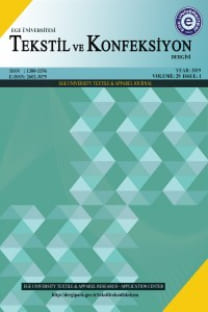Comparison of the fastness properties and color values of cotton fabrics knitted from air-vortex and ring spun yarns
Vorteks ve ring ipliklerinden üretilmiş pamuklu örme kumaşların renk değerleri ve renk haslıkları açısından karşılaştırılması
___
- 1.Murata Vortex Spinner, No. 810 Instruction Manual, Murata Machinery Ltd., Muratec.
- 2.Basal, G., Oxenham, W., 2006, “Effects of some Process Parameters on the Structure and Properties of Air-vortex Spun Yarn”, Textile Res. J., Vol.76(6), pp. 492-499.
- 3.Ortlek, H., Ulku, S., 2005, “Effects of Some Variables on Properties of 100% Cotton Air-Vortex Spun Yarn”, Textile Res. J., Vol. 75(6), pp. 458-461.
- 4.Soe A.K., Takahashi M.,Nakajima M., 2004, “Structure and Properties of MVS Yarns in Comparison with Ring Yarns and Open-End Rotor Spun Yarns”, Textile Res. J., Vol. 74(9), pp. 819-826.
- 5.Beceren, Y., Uygun Nergis, B., 2008, “Comparison of the Effects of Cotton Yarns Produced by New, Modified and Conventional Spinning Systems on Yarn and Knitted Fabric Performance”, Textile Res. J., Vol. 78(4), pp. 297-303.
- 6.Basal, G., Oxenham, W., 2003, “Vortex Spun Yarns vs Air-jet Spun Yarn”, AUTEX Res. J., Vol. 3(3), pp. 96-101.
- 7.Li, Q., Brady, PR., Hurren, CJ. 2008, “The dimensional and mechanical properties of wool/polyester fabrics made from vortex and ring-spun yarns”, The J. of The Textile Institute , Vol. 99(6), pp. 561-568.
- 8.Ortlek, HG., Onal, L., 2008, “Comparative Study on the Characteristics of Knitted Fabrics Made of Vortex-Spun Viscose Yarns”, Fibers and Polymers, Vol. 9(2), pp. 194-199.
- 9.Omeroglu, S., Becerir, B., 2005, “Comparison of Color Values of Plain Cotton Fabrics Woven from Ring- and Compact-Spun Yarns”, Indian J. of Fibre Textile Res., Vol. 30(4), pp. 402-406.
- 10.Becerir B., Omeroglu S., 2007, “Comparison of Color Values of Plain Cotton Fabrics Knitted from Ring- and Compact-Spun Yarns”, AATCC Review, Vol. 7(6), pp. 41-46.
- 11.ISO 105-C06, 1994, “Textiles - Tests for colour fastness - Part C06: Colour fastness to domestic and commercial laundering”.
- 12.ISO 105-E04, 1994, “Textiles - Tests for colour fastness - Part E04: Colour fastness to perspiration”.
- 13.ISO 105-X12, 2001, “Textiles - Tests for colour fastness - Part X12: Colour fastness to rubbing”.
- 14.ISO 105-B02, 1994, “Textiles - Tests for colour fastness - Part B02: Colour fastness to artificial light: Xenon arc fading lamp test”.
- ISSN: 1300-3356
- Yayın Aralığı: 4
- Yayıncı: Ege Üniversitesi Tekstil ve Konfeksiyon Araştırma & Uygulama Merkezi
Halil İbrahim İÇOĞLU, Ali KİREÇCİ, Parlakyiğit Pınar ERDAL
BAMBU ELYAF TAKVİYELİ KOMPOZİT YAPILAR VE MEKANİK ÖZELLİKLERİ
S. Müge YÜKSELOĞLU, Hürol YÖNEY
Hasan ÖZGÜNAY, Mehmet Mete MUTLU, Çiğdem KILIÇARİSLAN, Aykan YUMURTAŞ
Mehmet Mete MUTLU, Hasan ÖZGÜNAY, Çiğdem KILIÇARİSLAN, Aykan YUMURTAŞ
ÖRÜLMÜŞ FANTAZİ İPLİKLERDE ÜRETİM PARAMETRELERİNİN KUMAŞLARIN TERMOFİZYOLOJİK ÖZELLİKLERİNE ETKİSİ
Arzu TURAY, Nilgün ÖZDİL, Gamze SÜPÜREN, Gonca ÖZÇELİK
Örülmüş fantazi ipliklerde üretim parametrelerinin kumaşların termofizyolojik özelliklerine etkisi
Gonca ÖZÇELİK, Nilgün ÖZDİL, Gamze SÜPÜREN, Arzu TURAY
Kenan YILDIRIM, Şule ALTUN, Yusuf ULUCAY
Ali KİREÇCİ, Pınar PARLAKYİGİT ERDAL, Halil İbrahim İÇOĞLU
BAYAN PANTOLONUNDA KUMAŞ YAPILARININ MODEL VE KALIP TASARIMINA ETKİLERİ
